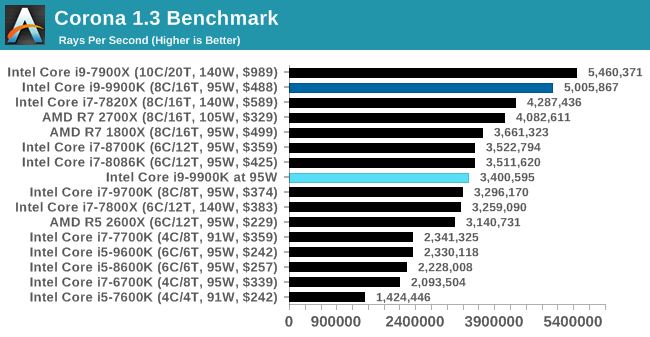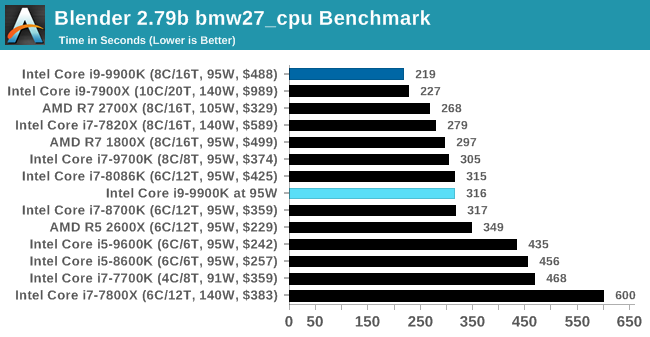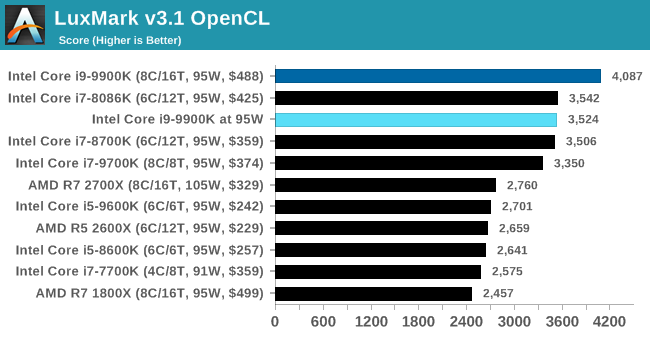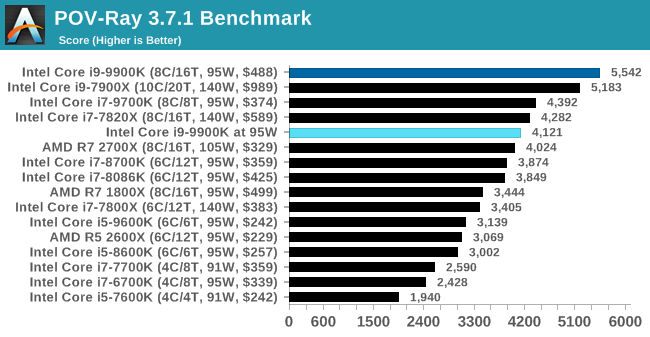The Intel Core i9-9900K at 95W: Fixing The Power for SFF
by Ian Cutress on November 29, 2018 8:00 AM ESTCPU Performance: Rendering Tests
Rendering is often a key target for processor workloads, lending itself to a professional environment. It comes in different formats as well, from 3D rendering through rasterization, such as games, or by ray tracing, and invokes the ability of the software to manage meshes, textures, collisions, aliasing, physics (in animations), and discarding unnecessary work. Most renderers offer CPU code paths, while a few use GPUs and select environments use FPGAs or dedicated ASICs. For big studios however, CPUs are still the hardware of choice.
All of our benchmark results can also be found in our benchmark engine, Bench.
Corona 1.3: Performance Render
An advanced performance based renderer for software such as 3ds Max and Cinema 4D, the Corona benchmark renders a generated scene as a standard under its 1.3 software version. Normally the GUI implementation of the benchmark shows the scene being built, and allows the user to upload the result as a ‘time to complete’.
We got in contact with the developer who gave us a command line version of the benchmark that does a direct output of results. Rather than reporting time, we report the average number of rays per second across six runs, as the performance scaling of a result per unit time is typically visually easier to understand.
The Corona benchmark website can be found at https://corona-renderer.com/benchmark

When we apply a full-fat rendering test, the 9900K at 95W scores around the i7-9700K which is a similar CPU with no hyperthreading.
Blender 2.79b: 3D Creation Suite
A high profile rendering tool, Blender is open-source allowing for massive amounts of configurability, and is used by a number of high-profile animation studios worldwide. The organization recently released a Blender benchmark package, a couple of weeks after we had narrowed our Blender test for our new suite, however their test can take over an hour. For our results, we run one of the sub-tests in that suite through the command line - a standard ‘bmw27’ scene in CPU only mode, and measure the time to complete the render.
Blender can be downloaded at https://www.blender.org/download/

Similar scenes with Blender, where the 9900K at 95W is actually 50% slower, and performs around the mark of the 9700K.
LuxMark v3.1: LuxRender via Different Code Paths
As stated at the top, there are many different ways to process rendering data: CPU, GPU, Accelerator, and others. On top of that, there are many frameworks and APIs in which to program, depending on how the software will be used. LuxMark, a benchmark developed using the LuxRender engine, offers several different scenes and APIs.
In our test, we run the simple ‘Ball’ scene on both the C++ and OpenCL code paths, but in CPU mode. This scene starts with a rough render and slowly improves the quality over two minutes, giving a final result in what is essentially an average ‘kilorays per second’.


The drop in our Luxmark test isn't as severe as what we see in blender, but the 95W mode causes the 9900K to be again around the level of a 9700K.
POV-Ray 3.7.1: Ray Tracing
The Persistence of Vision ray tracing engine is another well-known benchmarking tool, which was in a state of relative hibernation until AMD released its Zen processors, to which suddenly both Intel and AMD were submitting code to the main branch of the open source project. For our test, we use the built-in benchmark for all-cores, called from the command line.
POV-Ray can be downloaded from http://www.povray.org/













101 Comments
View All Comments
edzieba - Thursday, November 29, 2018 - link
The difference is the ARM chips being labelled with the short-term term frequencies and performance, while Intel put the steady state values on the box. Motherboard manufacturers throw the box values right out the window, but if Intel were to dictate /those/ the wailing and gnashing of teeth from the peanut gallery would be cacaphonous.melgross - Thursday, November 29, 2018 - link
Its just a matter of semantics. It doesn’t have to be spelled out.Targon - Thursday, November 29, 2018 - link
There are actually three primary states. Base clocks, boost or turbo speeds, and then you can get thermal throttle which will actually lower the speed below the base clock speed. If the i9-9900k has a base of 3.6GHz, a turbo that goes up to 5GHz, but you have poor cooling, you may be seeing the CPU sticking to that 3.6GHz, or even below it if the temperatures get too high.This is where those very thin laptops may have Ryzen versions performing better than Intel, because of the temperatures keeping the chip running at or even below base speeds. For a small form factor machine, will the 9900k be running at base speeds ALL THE TIME due to temperatures/TDP/cooling? In the same small form factor case, would a Ryzen 7 2700X end up having a similar level of performance after several hours(to allow the heat generation to stabilize)? If you start when things are COLD, you could turn the machine on and run benchmarks, and see better numbers than if the machine were already on and you had been running intensive applications for several hours prior to running the benchmarks.
eastcoast_pete - Thursday, November 29, 2018 - link
@Ian: Thanks for this informative test and review. One comment, one question/request. Comment: I continue to be struck by Intel's prowess when AVX512/AVX2 comes into play. I am also (negatively) impressed by the thermal load use of these instructions causes. The reduction in performance when using AVX512/AVX2 under strict adherence to a TdP of 95 Wh speaks volumes. Did you ever have a chance to ask Intel why running AVX makes their chips so power-hungry? Even if not, I'd appreciate your thoughts on why AVX makes Intel's chips run so hot.Here my question/request: I now that you/Anandtech have a large dataset on x264 video encoding speeds. However, especially for i7s and AMD's six-core and up Zen chips, I'd like to know how they fare when encoding/transcoding a 2160p 10bit video, as that is now in increasing demand, and really makes the processor sweat (and slow down, a lot). Any chance you and your colleagues can add that to the encoding tests? If space is an issue, I suggest to dump the x264 720p speed test; even a lowly Athlon or Celeron chip does that quite well, and at good speed.
HStewart - Thursday, November 29, 2018 - link
I believe you can turn off AVX512 in bios - it use in special application that need the speedAlso I would think the external GPU's is another major factor in considering power requirements on a system.
I don't belkieve there is any power needs or reduction in topp speed for AVX2 only that AVX512 uses extra power on system and top frequency are reduce if being used.
One thing about AVX2 - on Intel it is 256bit and AMD has dual 128 bits currently - not sure about new Zen's coming out next year. But at least with PowerDirector, it give you significantly performance increase
GreenReaper - Saturday, December 1, 2018 - link
It's pretty simple, really: the more data the CPU has to process in parallel, the more horsepower it uses. It's like doubling or quadrupling the number of active cylinders in an engine - you gain performance, but it requires more power and produces more heat. That's why they're off if not in use.Dedicated GPU blocks for video coding will also use more power, but are likely to be far more efficient than doing the operations with general code - as long as it's within their defined capabilities. (Similarly, if you had to do the equivalent of the AVX operations without the relevant hardware, it would probably use even more power than it currently does, at least over the extra time it took.)
Davenreturns - Thursday, November 29, 2018 - link
I have found much confusion among the readers on hardware review websites when it comes to this issue. So I would like to present some information from Anandtech's Bench tool in order to clarify the situation for me and others hopefully:Looking at the CPU Power Bench
https://www.anandtech.com/bench/CPU-2019/2194
The following two processors have these results under full package, full load:
i7-6700k 82.55W First mainstream desktop 14 nm processor, 95W TDP according to Intel
i9-9900k 168.48W Latest mainstream desktop 14 nm processor, 95W TDP according to Intel
I assume that these two values were measured in unlimited mode. If this is the case, this means that the power listed above is when all cores/threads are loaded at full max turbo mode. So if you are expecting a certain level of performance given that Intel advertises 95W for both CPUs, then you are being misled and may not get the performance you are expecting when upgrading the CPU but not your cooling.
This is a CHANGE from the past in how Intel uses TDP without telling the customer. It also highlights that Intel use to be conservative with cores/clocks/turbo when they had no competition and were able to shrink nodes between Nehalem and Skylake. Now they are PRETENDING that they can just double the cores and raise clocks on the same node and not increase power. Please correct me if I'm wrong, but it doesn't look like this is the case anymore.
AlyxSharkBite - Thursday, November 29, 2018 - link
Really interesting how when you limit it to 95W it’s really close to the 2700X4800z - Thursday, November 29, 2018 - link
A power unlimited 2700x. Also this article doesn't include any games. If it did you'd see the 9900k still does much better, because games don't use all 8 cores.schujj07 - Thursday, November 29, 2018 - link
2700X - 117.18W Max = 11.6% over stated TDP9900K - 168.48W Nax = 77.3% over stated TDP
Don't forget not everyone views gaming and the end all be all form of benchmarking. Would it be interesting to see if it affects the gaming sure. It most certainly would affect those who game and stream at the same time.